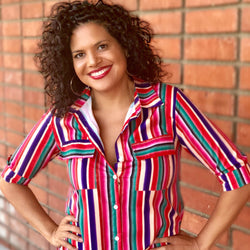
Multicultural Holiday Gift Guide 2016
As a multicultural mama of 4, this year has been a difficult one. From the hate-filled rhetoric during the Presidential election to conversations surrounding Black Lives Matters vs. Blue Lives Matter, my children, like many others were left with many questions. As parents, it's difficult to shelter our children from hearing negative conversations. Some of the things my littles heard came straight from the playground, during play dates, or in the supermarket checkout line. “Apa, did you know so and so’s dad said we have to go back to Korea”, one little would say.
“Mama, so and so said we won’t be able to go to Mexico because a wall is going to be built”, the other little would say. On top of their list of queries was the question of if this country of ours wants us here?
Their Apa and I would sit them down and try to explain that our country is founded on the backs of Native Americans and immigrants which is one of the things that makes our country so great. During this time we gave plenty of hugs reassuring them that we would see our loved ones and don't have to leave because this is our home. We are a multiracial family of Mexican, Black and Korean heritage and WE ARE American.
It turns out I wasn’t alone in the discussions I was having with my children on what it means to be an American? My White, Black, Asian, Multiracial friends were all finding ways to talk to their kids about this period in our history. They were looking for answers and finding ways to teach their children to look at other cultures with love and appreciation but didn’t quite know where to start. I found myself offering tips that I use in my work and as an advocate in the multicultural, diversity and inclusion space.
Over coffee and on playdates, I shared ways to learn about one another and applauded them for being open to becoming culturally responsive parents/caregivers/teachers/people. We all knew what was at stake teaching our children how to interact in a society that doesn’t always look like them; that we come in all shapes, sizes, skin tones, hair textures, religions, abilities, and speaking different languages. As we talked, I shared the analogy of how one “child-proofs” or in the case of living with elderly, “senior-proofs” the home, to keep loved ones safe, so too must we create a home and an environment where children feel safe to learn about other cultures and ask probing questions. In essence, we are protecting them from a rude awakening once they step out into the world. The real and wonderfully, diverse world. I call it “culture-proofing” the home.
Being culturally responsive and culture-proofing the home is based on the idea that being color blind does not work. I tell folks it’s ok to see color, it’s all the “stuff” we attach to different cultures and the assumption about them, that doesn’t work. Cultural diversity and different abilities intersect on the play ground, in classrooms, at our parks, in our neighborhoods, and during group activities. Culture proofing can start by recognizing our own limits yet maintaining a willingness to learn about one another. It’s about encouraging interactions that form diverse and inclusive classrooms and communities by providing access to different cultures in and outside of the home. We need to be amenable and agents of change by always asking who is not being heard or seen? My older kids call it being “woke” when you acknowledge the experiences and perspectives of the oppressed and marginalized and then ask how can this situation be changed?
Now that the holidays are here, it is the perfect time to get started. For parents and caregivers, the challenge can come with explaining diverse cultures with respect when perhaps we may not have the information needed but that should not impede the goal of being culturally responsive and learning about one another. Like with other “proofing” of the home, ignorance can sometimes hurt our loved ones. And like the other “proofing”, there are some costs and real efforts that have to be made. You exchange the costs of updating and retrofitting your home with child-proofing and senior-proofing with such things as outlet covers, safety gates, corner bumpers, stair lifts and grab bars with multicultural artwork, ethnic foods, global fashion, diverse books, music and travel (local and abroad). While some changes may take an investment, the outcome of having children that are mini global citizens with a greater world view is a wonderful payoff.











Leave a comment
This site is protected by hCaptcha and the hCaptcha Privacy Policy and Terms of Service apply.